Green Manure Amendment in Paddies Improves Soil Carbon Sequestration but Cannot Substitute the Critical Role of N Fertilizer in Rice Production
Abstract
:1. Introduction
2. Materials and Methods
2.1. Experimental Design
2.2. Sampling and Measurements
2.3. Data Analyses
2.4. Statistical Analyses
3. Results
3.1. Soil Fertility and Carbon Management Indices
3.2. CH4 Emitting Rate
3.3. Rice Yield and Cumulative CH4 Emissions
3.4. mcrA and pmoA Genes
3.5. Correlation Analysis between Grain Yield, CH4 Emissions and Soil Index
4. Discussion
4.1. Soil Carbon Management Indices
4.2. CH4 Emissions
4.3. Grain Yield and CH4 Emission Intensity
5. Conclusions
Author Contributions
Funding
Conflicts of Interest
References
- Lal, R. Soil carbon sequestration impacts on global climate change and food security. Science 2004, 304, 1623–2627. [Google Scholar] [CrossRef] [Green Version]
- Jarecki, M.K.; Lal, R. Crop management for soil carbon sequestration. Crit. Rev. Plant Sci. 2003, 22, 471–502. [Google Scholar] [CrossRef]
- Oechaiyaphum, K.; Ullah, H.; Shrestha, R.P.; Datta, A. Impact of long-term agricultural management practices on soil organic carbon and soil fertility of paddy fields in Northeastern Thailand. Geoderma Reg. 2020, 22, e00307. [Google Scholar] [CrossRef]
- Haynes, R.J. Labile organic matter fractions as central components of the quality of agricultural soils: An overview. In Advances in Agronomy; Academic Press: Cambridge, MA, USA, 2005; pp. 221–268. [Google Scholar]
- Lenka, S.; Choudhary, R.; Lenka, N.K.; Saha, J.K.; Amat, D.; Patra, A.K.; Gami, V.; Singh, D. Nutrient management drives the direction and magnitude of nitrous oxide flux in crop residue-returned soil under different soil moisture. Front. Environ. Sci. 2022, 10, 857233. [Google Scholar] [CrossRef]
- Hurisso, T.T.; Culman, S.W.; Horwath, W.R.; Wade, J.; Cass, D.; Beniston, J.W.; Bowles, T.M.; Grandy, A.S.; Franzluebbers, A.J.; Schipanski, M.E.; et al. Comparison of permanganate-oxidizable carbon and mineralizable carbon for assessment of organic matter stabilization and mineralization. Soil Sci. Soc. Am. J. 2016, 80, 1352–1364. [Google Scholar] [CrossRef]
- Kim, S.Y.; Gutierrez, J.; Kim, P.J. Unexpected stimulation of CH4 emissions under continuous no-tillage system in mono-rice paddy soils during cultivation. Geoderma 2016, 267, 34–40. [Google Scholar] [CrossRef]
- Lenka, S.; Lenka, N.K.; Singh, R.C.; Manna, M.C.; Misra, A.K.; Rautaray, S.K. Tillage and manure induced changes in carbon storage and carbon management index in soybean-wheat cropping system in the vertisols of central India. Natl. Acad. Sci. Lett. 2015, 38, 461–464. [Google Scholar] [CrossRef]
- Carlson, K.M.; Gerber, J.S.; Mueller, N.D.; Herrero, M.; MacDonald, G.K.; Brauman, K.A.; Havlik, P.; O’Connell, C.S.; Johnson, J.A.; Saatchi, S.; et al. Greenhouse gas emissions intensity of global croplands. Nat. Clim. Chang. 2017, 7, 63–68. [Google Scholar] [CrossRef]
- Seck, P.A.; Diagne, A.; Mohanty, S.; Wopereis, M.C.S. Crops that feed the world 7: Rice. Food Secur. 2012, 4, 7–24. [Google Scholar] [CrossRef]
- Hong, X.; Ma, C.; Gao, J.; Su, S.; Li, T.; Luo, Z.; Duan, R.; Wang, Y.; Bai, L.; Zeng, X. Effects of different green manure treatments on soil apparent N and P balance under a 34-year double-rice cropping system. J. Soils Sediments 2019, 19, 73–80. [Google Scholar] [CrossRef]
- Hou, P.; Xue, L.; Wang, J.; Petropoulos, E.; Deng, X.; Qiao, J.; Xue, L.; Yang, L. Continuous milk vetch amendment in rice-fallow rotation improves soil fertility and maintains rice yield without increasing CH4 emissions: Evidence from a long-term experiment. Agric. Ecosyst. Environ. 2022, 325, 107774. [Google Scholar] [CrossRef]
- Raheem, A.; Zhang, J.; Huang, J.; Jiang, Y.; Siddik, M.A.; Deng, A.; Gao, J.; Zhang, W. Greenhouse gas emissions from a rice-rice-green manure cropping system in South China. Geoderma 2019, 353, 331–339. [Google Scholar] [CrossRef]
- USDA. Carbon to Nitrogen Ratios in Cropping Systems; USDA NRCS East National Technology Support Center: Greensboro, NC, USA, 2011.
- Cai, Z.; Shan, Y.; Xu, H. Effects of nitrogen fertilization on CH4 emissions from rice fields. Soil Sci. Plant Nutr. 2007, 53, 353–361. [Google Scholar] [CrossRef]
- Banger, K.; Tian, H.; Lu, C. Do nitrogen fertilizers stimulate or inhibit methane emissions from rice fields? Glob. Chang. Biol. 2012, 18, 3259–3267. [Google Scholar] [CrossRef]
- Craine, J.M.; Morrow, C.; Fierer, N. Microbial nitrogen limitation increases decomposition. Ecology 2007, 88, 2105–2113. [Google Scholar] [CrossRef]
- Hobbie, S.E. Nitrogen effects on decomposition: A five-year experiment in eight temperate sites. Ecology 2008, 89, 2633–2644. [Google Scholar] [CrossRef]
- Lu, P.; Shan, Y.-H.; Yang, L.-Z.; Han, Y. Influence of green manure crop on nitrogen concentration in soil solution of paddy field and rice yield. Soils 2006, 38, 270–275. (In Chinese) [Google Scholar]
- Hou, P.; Yuan, W.; Li, G.; Petropoulos, E.; Xue, L.; Feng, Y.; Xue, L.; Yang, L.; Ding, Y. Deep fertilization with controlled-release fertilizer for higher cereal yield and N utilization in paddies: The optimal fertilization depth. Agron. J. 2021, 113, 5027–5039. [Google Scholar] [CrossRef]
- Liu, S.; Zhang, Y.; Lin, F.; Zhang, L.; Zou, J. Methane and nitrous oxide emissions from direct-seeded and seedling-transplanted rice paddies in southeast China. Plant Soil 2014, 374, 285–297. [Google Scholar] [CrossRef]
- Hou, P.; Yu, Y.; Xue, L.; Petropoulos, E.; He, S.; Zhang, Y.; Pandey, A.; Xue, L.; Yang, L.; Chen, D. Effect of long term fertilization management strategies on methane emissions and rice yield. Sci. Total Environ. 2020, 725, 138261. [Google Scholar] [CrossRef]
- Lu, R.K. Methods of Soil and Agro-Chemical Analysis; Chinese Agriculture Science and Technology Press: Beijing, China, 2000. (In Chinese) [Google Scholar]
- Blair, G.J.; Lefroy, R.D.B.; Lisle, L. Soil carbon fractions based on their degree of oxidation, and the development of a carbon management index for agricultural systems. Aust. J. Agric. Res. 1995, 46, 1459–1466. [Google Scholar] [CrossRef]
- Mosier, A.R.; Halvorson, A.D.; Reule, C.A.; Liu, X.J. Net global warming potential and greenhouse gas intensity in irrigated cropping systems in northeastern Colorado. J. Environ. Qual. 2006, 35, 1584–1598. [Google Scholar] [CrossRef] [PubMed] [Green Version]
- Dheri, G.S.; Nazir, G. A review on carbon pools and sequestration as influenced by long-term management practices in a rice–Wheat cropping system. Carbon Manag. 2021, 12, 559–580. [Google Scholar] [CrossRef]
- Yang, Z.; Zheng, S.; Nie, J.; Liao, Y.; Xie, J. Effects of long-term winter planted green manure on distribution and storage of organic carbon and nitrogen in water-stable aggregates of reddish paddy soil under a double-rice cropping system. J. Integr. Agric. 2014, 13, 1772–1781. [Google Scholar] [CrossRef] [Green Version]
- Wang, W.; Zhu, W. Soil retention of 15N in a simulated N deposition study: Effects of live plant and soil organic matter content. Plant Soil 2012, 351, 61–72. [Google Scholar] [CrossRef]
- Yao, Z.; Zheng, X.; Dong, H.; Wang, R.; Mei, B.; Zhu, J. A 3-year record of N2O and CH4 emissions from a sandy loam paddy during rice seasons as affected by different nitrogen application rates. Agric. Ecosyst. Environ. 2012, 152, 1–9. [Google Scholar] [CrossRef]
- Malyan, S.K.; Bhatia, A.; Kumar, A.; Gupta, D.K.; Singh, R.; Kumar, S.S.; Tomer, R.; Kumar, O.; Jain, N. Methane production, oxidation and mitigation: A mechanistic understanding and comprehensive evaluation of influencing factors. Sci. Total Environ. 2016, 572, 874–896. [Google Scholar] [CrossRef]
- Le Mer, J.; Roger, P. Production, oxidation, emission and consumption of methane by soils: A review. Eur. J. Soil Biol. 2001, 37, 25–50. [Google Scholar] [CrossRef]
- Kong, D.; Li, S.; Jin, Y.; Wu, S.; Chen, J.; Hu, T.; Wang, H.; Liu, S.; Zou, J. Linking methane emissions to methanogenic and methanotrophic communities under different fertilization strategies in rice paddies. Geoderma 2019, 347, 233–243. [Google Scholar] [CrossRef]
- Fan, X.; Yu, H.; Wu, Q.; Ma, J.; Xu, H.; Yang, J.; Zhuang, Y. Effects of fertilization on microbial abundance and emissions of greenhouse gases (CH4 and N2O) in rice paddy fields. Ecol. Evol. 2016, 6, 1054–1063. [Google Scholar] [CrossRef] [Green Version]
- Zhou, G.; Gao, S.; Xu, C.; Dou, F.; Shimizu, K.; Cao, W. Rational utilization of leguminous green manure to mitigate methane emissions by influencing methanogenic and methanotrophic communities. Geoderma 2020, 361, 114071. [Google Scholar] [CrossRef]
- Dash, P.K.; Roy, K.S.; Neogi, S.; Nayak, A.K.; Bhattacharyya, P. Gaseous carbon emission in relation to soil carbon fractions and microbial diversities as affected by organic amendments in tropical rice soil. Arch. Agron. Soil Sci. 2014, 60, 1345–1361. [Google Scholar] [CrossRef]
- Tegeder, M.; Masclaux-Daubresse, C. Source and sink mechanisms of nitrogen transport and use. New Phytol. 2018, 217, 35–53. [Google Scholar] [CrossRef] [PubMed] [Green Version]
- Ladha, J.K.; Pathak, H.; Krupnik, T.J.; Six, J.; van Kessel, C. Efficiency of fertilizer nitrogen in cereal production: Retrospects and prospects. In Advances in Agronomy; Academic Press: Cambridge, MA, USA, 2005; pp. 85–156. [Google Scholar]
- Ray, D.K.; Gerber, J.S.; MacDonald, G.K.; West, P.C. Climate variation explains a third of global crop yield variability. Nat. Commun. 2015, 6, 5989. [Google Scholar] [CrossRef] [PubMed] [Green Version]
- Zhang, Q.; Tang, W.; Peng, S.; Li, Y. Limiting factors for panicle photosynthesis at the anthesis and grain filling stages in rice (Oryza sativa L.). Plant J. 2022, 109, 77–91. [Google Scholar] [CrossRef]
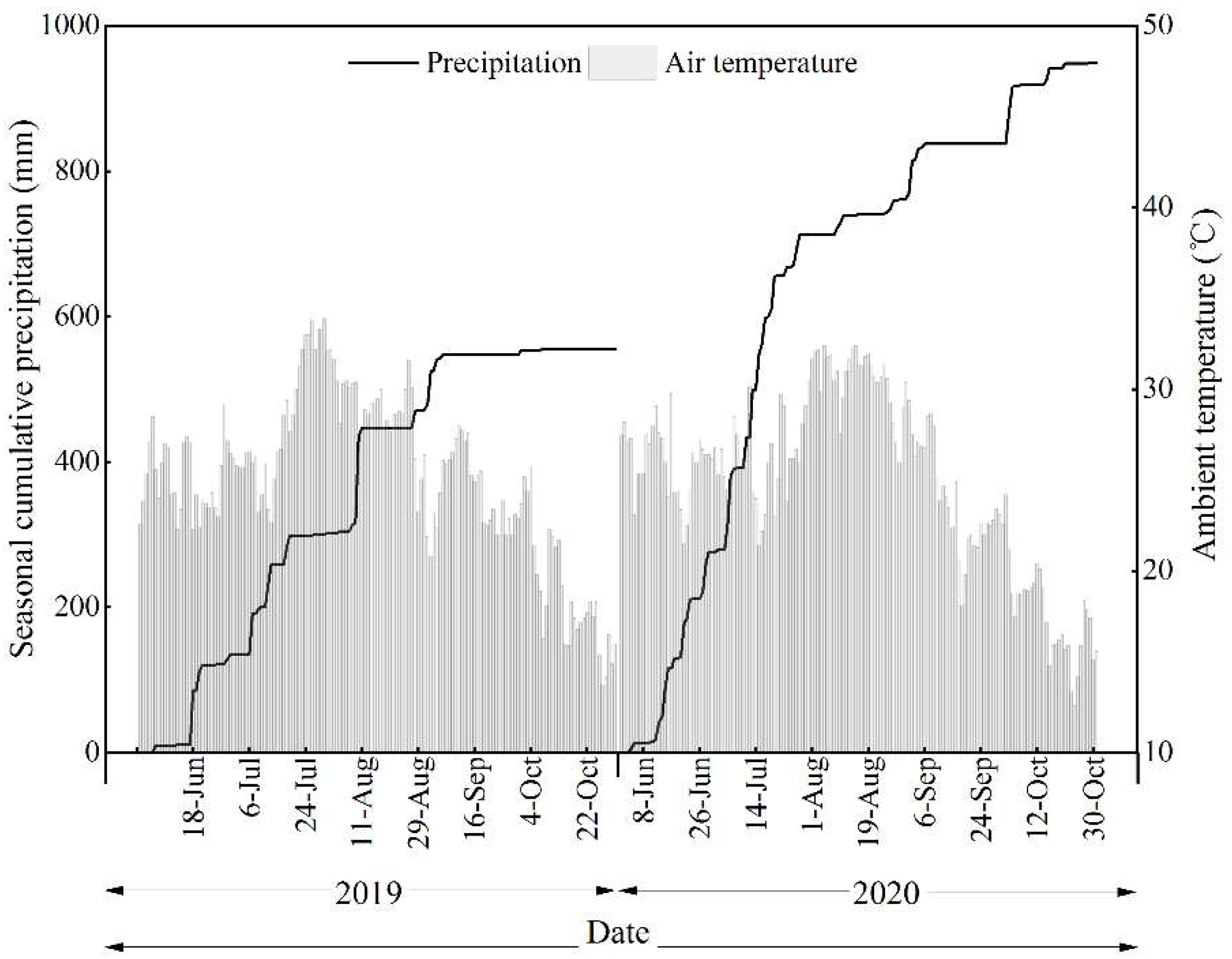
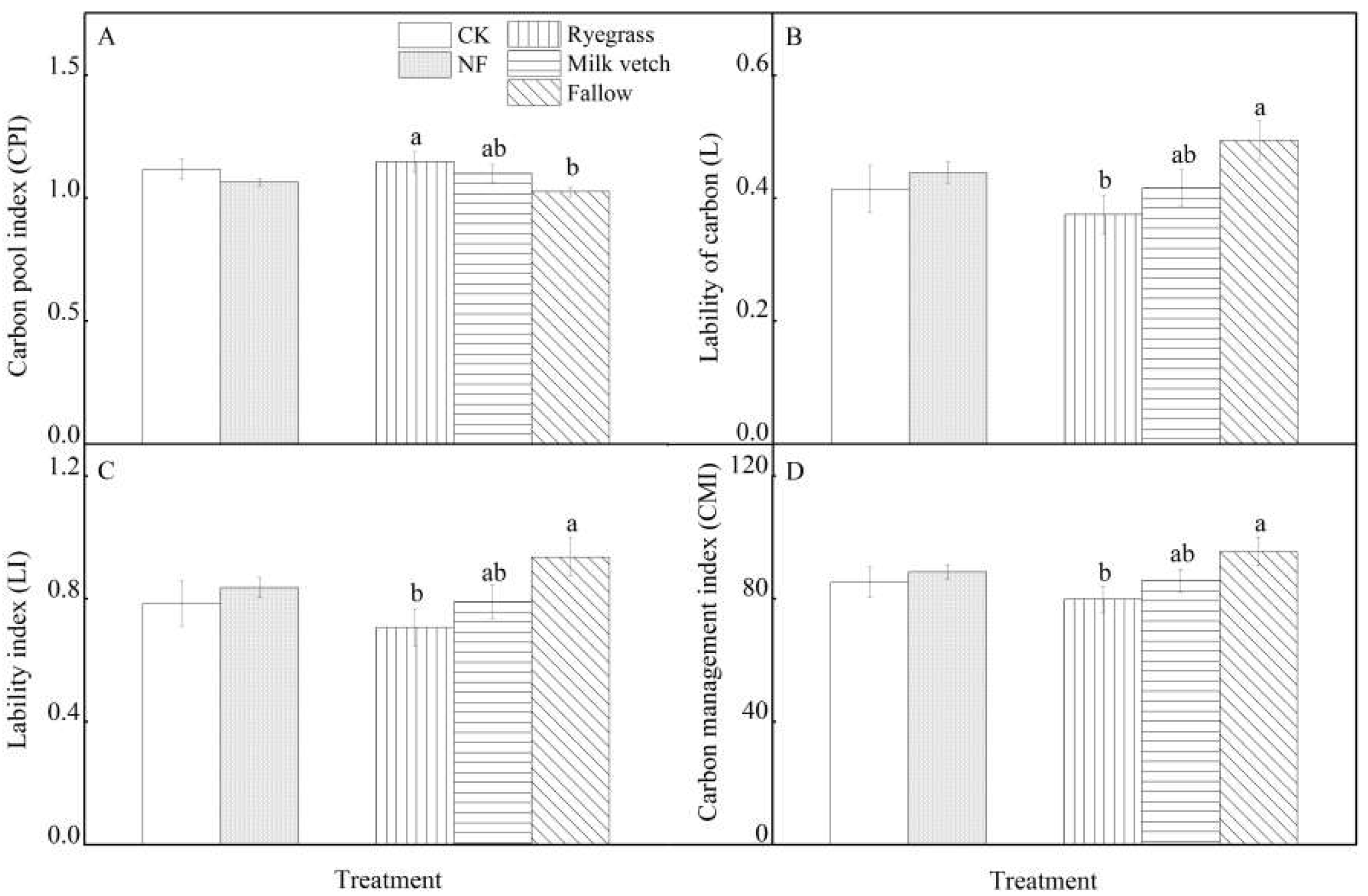
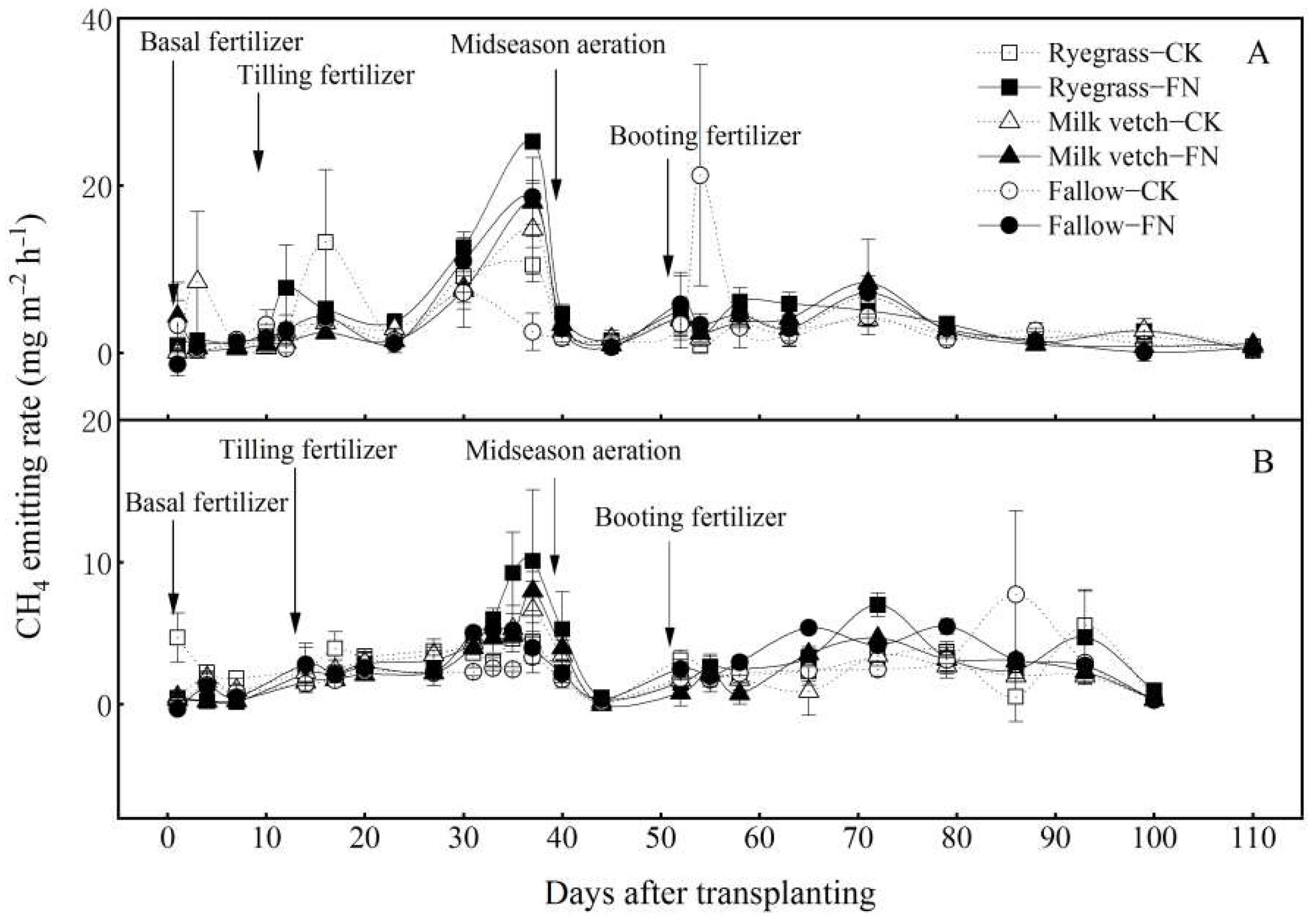
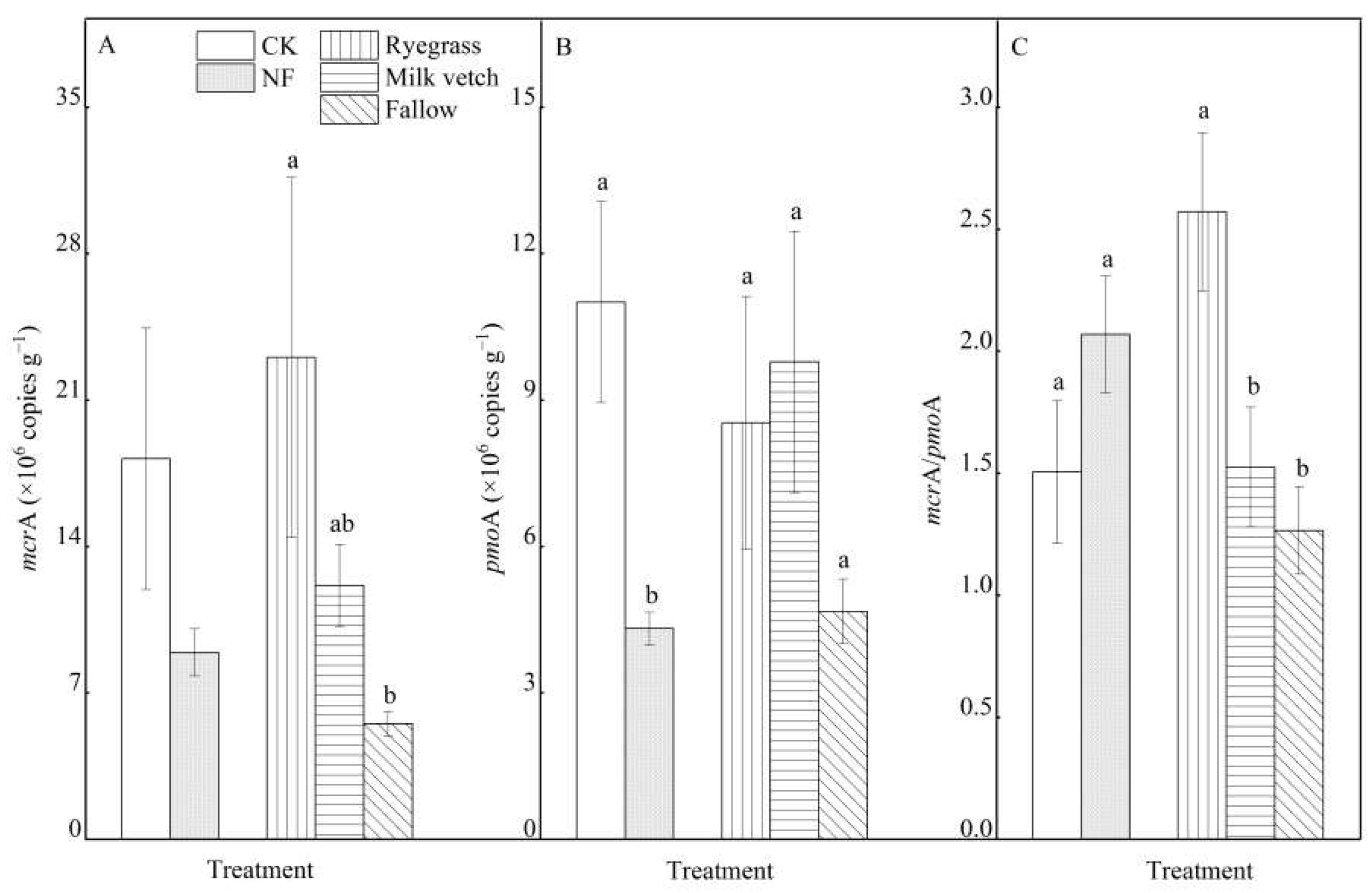
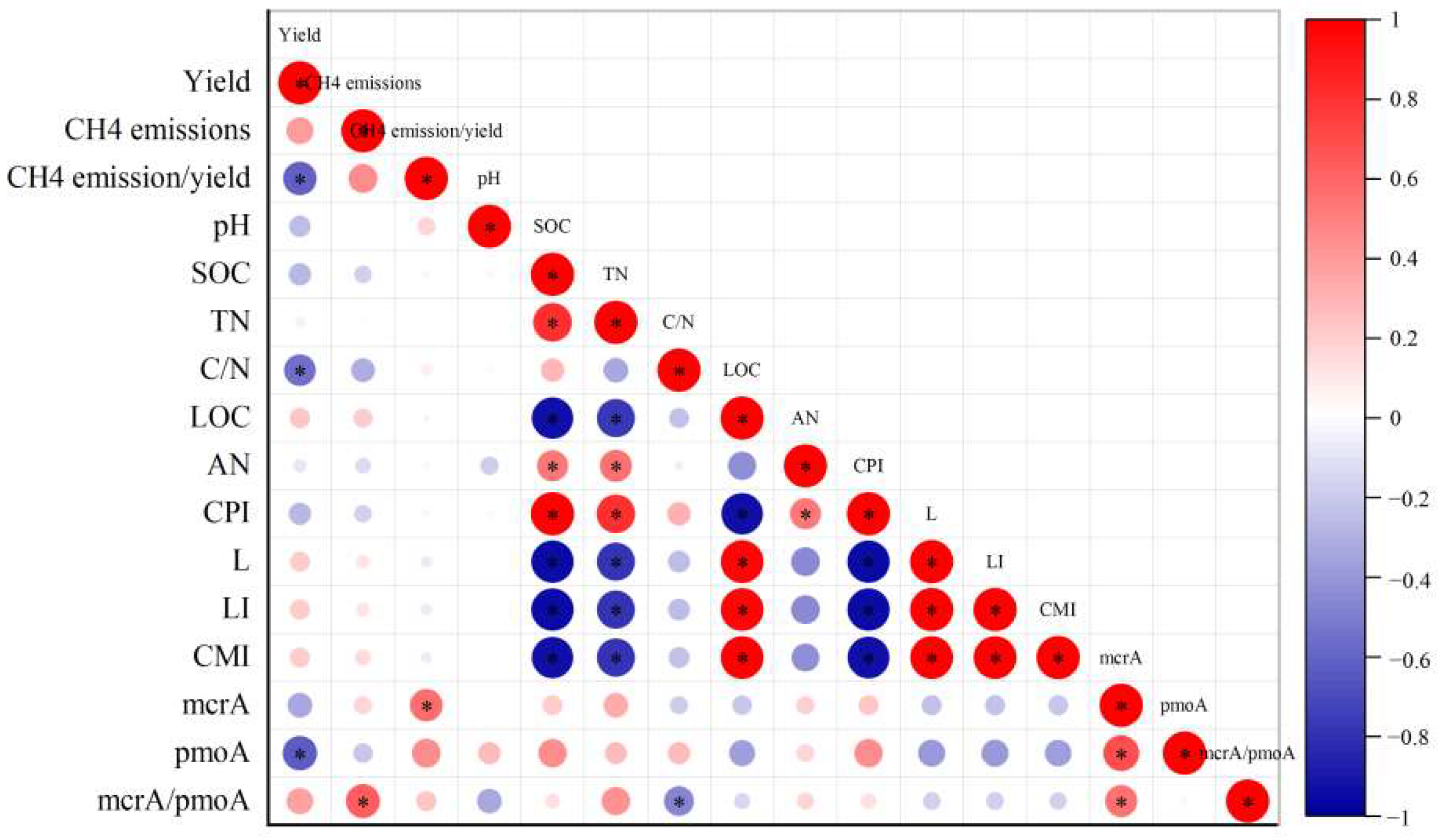
| Treatment | N (kg ha−1) | P2O5 (kg ha−1) | K2O (kg ha−1) | ||||||
|---|---|---|---|---|---|---|---|---|---|
| Basal | Tilling | Booting | Total | Basal | Total | Basal | Total | ||
| Ryegrass | CK | 0 | 0 | 0 | 0 | 81 | 81 | 81 | 81 |
| NF | 41 | 40 | 69 | 150 | 81 | 81 | 81 | 81 | |
| Milk vetch | CK | 0 | 0 | 0 | 0 | 81 | 81 | 81 | 81 |
| NF | 41 | 40 | 69 | 150 | 81 | 81 | 81 | 81 | |
| Fallow | CK | 0 | 0 | 0 | 0 | 81 | 81 | 81 | 81 |
| NF | 41 | 40 | 69 | 150 | 81 | 81 | 81 | 81 | |
| Treatment | pH | SOC (g kg−1) | TN (g kg−1) | C/N | LOC (g kg−1) | AN (mg kg−1) | |
|---|---|---|---|---|---|---|---|
| Ryegrass | CK | 6.08 a | 14.67 a | 1.69 a | 8.65 bc | 3.61 b | 172.33 a |
| NF | 5.99 a | 13.53 abc | 1.53 b | 8.86 abc | 3.92 ab | 151.33 ab | |
| Milk vetch | CK | 6.22 a | 14.30 ab | 1.51 b | 9.43 a | 3.85 ab | 149.67 ab |
| NF | 5.99 a | 12.80 bc | 1.55 ab | 8.28 c | 4.00 ab | 131.90 b | |
| Fallow | CK | 6.12 a | 12.27 c | 1.34 c | 9.17 ab | 4.22 a | 136.33 ab |
| NF | 6.03 a | 12.97 abc | 1.49 bc | 8.71 bc | 4.05 ab | 152.67 ab | |
| F values | |||||||
| Fertilization (F) | ns | ns | ns | 7.92 * | ns | ns | |
| Green manure (M) | ns | 4.13 * | 8.01 ** | ns | ns | ns | |
| F × M | ns | ns | 4.96 * | 5.68 * | ns | ns | |
| Soil Fertility | Fertilization (F) | Green Manure (M) | M × F |
|---|---|---|---|
| CPI | ns | 4.09 * | ns |
| L | ns | 4.20 * | ns |
| LI | ns | 4.20 * | ns |
| CMI | ns | 3.47 † | ns |
| mcrA | ns | 3.61 † | ns |
| pmoA | 7.99 * | 2.82 † | ns |
| mcrA/pmoA | 4.08 † | 8.21 ** | ns |
| Treatment | Yield (t ha−1) | Average CH4 Emission Rate (mg m−2 h−1) | Cumulative CH4 Emissions (kg ha−1) | CH4 Emission/Yield (g kg−1) | |
|---|---|---|---|---|---|
| Fertilization (F) | |||||
| CK | 5.02 b | 3.07 | 81.24 | 16.19 a | |
| NF | 8.27 a | 3.53 | 102.48 | 12.36 b | |
| Green manure (M) | |||||
| Ryegrass | 6.43 | 3.73 | 105.34 | 16.99 | |
| Milk vetch | 6.85 | 3.06 | 86.33 | 12.89 | |
| Fallow | 6.65 | 3.10 | 83.91 | 12.94 | |
| Year (Y) | |||||
| 2019 | 7.13 a | 3.90 a | 119.63 a | 17.11 a | |
| 2020 | 6.15 b | 2.69 b | 64.09 b | 11.43 b | |
| F values | |||||
| Fertilization (F) | 90.01 *** | ns | 4.04 † | 5.32 * | |
| Green manure (M) | ns | ns | ns | ns | |
| Year (Y) | 8.21 ** | 10.50 ** | 27.57 *** | 11.69 ** | |
| F × M | ns | ns | ns | ns | |
| F × Y | ns | ns | ns | ns | |
| M × Y | ns | ns | ns | ns | |
| F × M × Y | ns | ns | ns | ns | |
Publisher’s Note: MDPI stays neutral with regard to jurisdictional claims in published maps and institutional affiliations. |
© 2022 by the authors. Licensee MDPI, Basel, Switzerland. This article is an open access article distributed under the terms and conditions of the Creative Commons Attribution (CC BY) license (https://creativecommons.org/licenses/by/4.0/).
Share and Cite
Hou, P.; Xue, L.; Wang, J.; Petropoulos, E.; Xue, L.; Yang, L. Green Manure Amendment in Paddies Improves Soil Carbon Sequestration but Cannot Substitute the Critical Role of N Fertilizer in Rice Production. Agronomy 2022, 12, 1548. https://doi.org/10.3390/agronomy12071548
Hou P, Xue L, Wang J, Petropoulos E, Xue L, Yang L. Green Manure Amendment in Paddies Improves Soil Carbon Sequestration but Cannot Substitute the Critical Role of N Fertilizer in Rice Production. Agronomy. 2022; 12(7):1548. https://doi.org/10.3390/agronomy12071548
Chicago/Turabian StyleHou, Pengfu, Lixiang Xue, Jing Wang, Evangelos Petropoulos, Lihong Xue, and Linzhang Yang. 2022. "Green Manure Amendment in Paddies Improves Soil Carbon Sequestration but Cannot Substitute the Critical Role of N Fertilizer in Rice Production" Agronomy 12, no. 7: 1548. https://doi.org/10.3390/agronomy12071548
APA StyleHou, P., Xue, L., Wang, J., Petropoulos, E., Xue, L., & Yang, L. (2022). Green Manure Amendment in Paddies Improves Soil Carbon Sequestration but Cannot Substitute the Critical Role of N Fertilizer in Rice Production. Agronomy, 12(7), 1548. https://doi.org/10.3390/agronomy12071548







